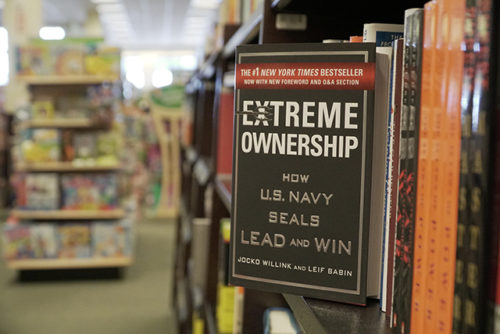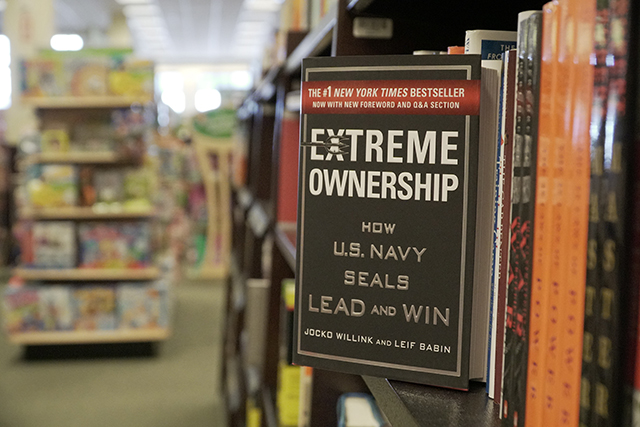Extreme Ownership, written by Jocko Willink and Leif Babin (two former Navy SEALs), is one of the most captivating books I’ve read in the past few years. The focus of the book is leadership and the two authors recount the principles they learned on the battlefield, and how those principles can be incorporated by leaders in all areas of business and life. The stories told in the book are engrossing, and the leadership principles are highly relevant and applicable.
The biggest idea of the book, as the title suggests, is ownership and the idea that, above all, a good leader must take responsibility for everything. You’re not just responsible for your job, you’re responsible for everything that enters your world. Ownership, like all the principles in the book, is driven home by real-life stories of lessons learned during combat.
 A mission gone wrong
A mission gone wrong
The book begins with the aftermath of Willink’s first major operation as a SEAL commander in Ramadi (one of the worst and most violent areas of Iraq). In the fog of war, a mission resulted in friendly fire that wounded a Navy SEAL and killed a friendly Iraqi soldier. After Willink had his operations shut down pending an investigation, he waited for his commanding officer and prepared a presentation of the mission and its failures. He wanted to explain what happened, who was to blame, and who might be relieved of their duties. Despite being able to outline multiple errors that led to the breakdown, Willink had the feeling that he was missing the root cause of the problem.
In front of the investigating committee, Willink asked his team who was to blame for the fratricide: “I didn’t positively identify the target before engaging,” said one SEAL; “I didn’t quickly enough radio our position to all friendly forces in the area when we changed building location,” said another. This went on as more team members stood up to state various failures.
Each time, Willink replied that they were not to blame for the incident. In the end, he tells the committee that as the senior commanding officer of the unit, he’s solely responsible for everything on the battlefield. Despite the substantial risk to his reputation and job, this was the only honest and true answer he could give. He wasn’t even with the troops when the incident broke out, but it didn’t matter. He was the leader, he was responsible.
A failure among his team was ultimately his failure to not train or lead properly, a failure in the mission was his failure to not plan for contingencies or communicate properly.
In your life
It was Willink’s attitude of extreme ownership that won respect and trust from his team and commanding officers. It’s clear that extreme ownership is the most important and evident principle of the book, but there are many others, and I’ll share a few that I look forward to incorporating into my life.
- There are no bad teams, only bad leaders. The authors tell a story about when they were instructors during a Navy SEAL training. There were six teams competing in various races and challenges. In one particular situation, one crew consistently finished first in every challenge, and another consistently finished last. They decided to switch the captains of these two teams. The results? The team that had finished last finished first. It was the same team, but they had a new leader at the helm. So, how did switching a leader make such a difference? The leader got the team to work together, putting aside their differences and asking them to put the objective first. Also, the team suddenly believed they could win, which meant they were all holding each other to a higher standard. As leaders, we need to accept the responsibility that our team’s performance is a reflection of us and our ability to lead.
- Belief. To convince and inspire others to follow and accomplish a mission, a leader must be a true believer in the mission. If you don’t believe, you won’t take the risks and overcome the hardships necessary to win. When a leader’s confidence breaks or they lose their belief, others see this and begin to question the leader and themselves. A large part of belief centers on the “why.” If you don’t understand why you’re doing something, it’s your responsibility to find out. This could mean asking more questions in a meeting, or going to your boss for clarification. It’s also your responsibility to make sure any task you delegate is clearly accompanied with a why, so the person performing the task has belief in you and the mission.
- Discipline = Freedom. This is the closing chapter in the book and one of the most powerful. A mantra of the authors, it’s easy to see discipline’s necessity in a military environment. However, this attitude can bear fruit in all aspects of life. The discipline to wake up early gives you the free time to pursue your goals. The discipline to eat healthy and exercise gives you freedom from sickness and disease. The discipline to manage your money gives you financial freedom. The path to freedom is through discipline. At work, this could be the discipline to arrive early, giving yourself more time in the morning to get things done when the office is quiet (often the most productive time). This would give you freedom in the evenings because you’ve completed your tasks. When you get a menial job, have the discipline to do it to the best of your ability, if you do well on the small things you might get recognized for it and promoted to bigger things. Discipline equals freedom.
Overall, I found this to be a great read with inspiring stories. Extreme ownership is something all of us can demonstrate, because even if you don’t feel like you are in charge of much, you are in charge of your life.









